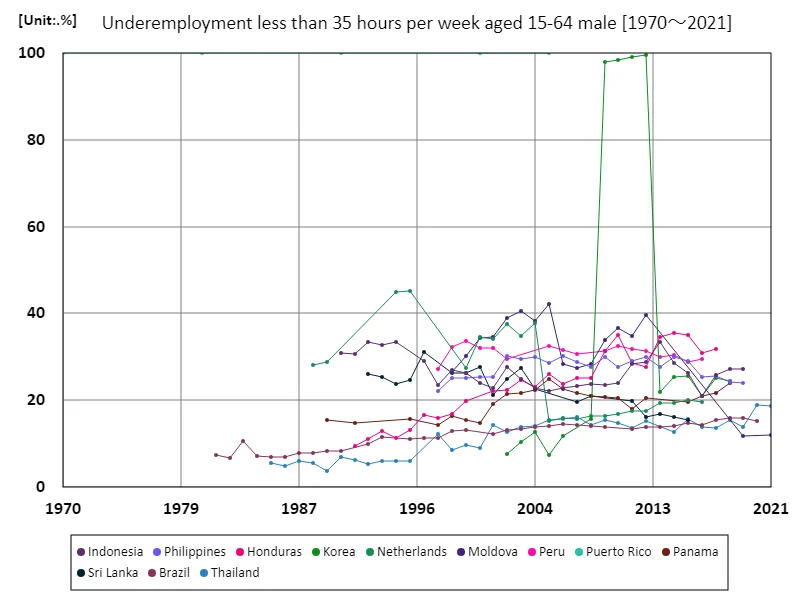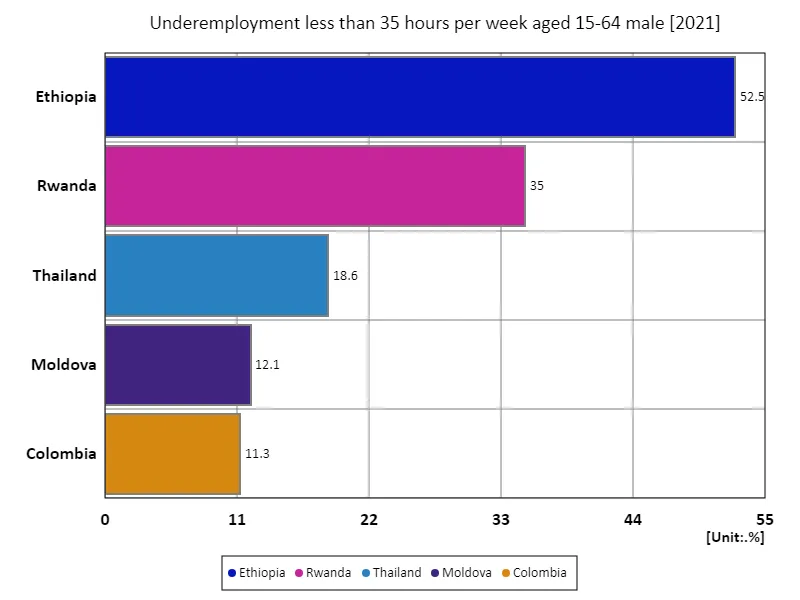Abstract
In terms of employment, Thailand’s high underemployment rate of 18.6% reflects structural challenges in the labour market. In particular, it is believed that factors such as the decline in labor force participation rate amid continuing economic growth and changes in the industrial structure are having an impact. Over the past few years, Thailand has become more dependent on tourism and agriculture, with many jobs in these sectors being seasonal. In these circumstances, more and more male workers are working less than 35 hours a week, and underemployment is becoming the norm. Furthermore, despite the need for improved education and skills, workers are unable to adapt to the market, and non-regular employment and short-time work are widespread. Going forward, greater labour market flexibility and improved skills could help improve underemployment rates.
Ages 15-64, underemployed (
The 100% underemployment rate recorded in Puerto Rico in 1970 was emblematic of the economic situation at the time. During this period, industrial change and economic instability in Puerto Rico left many people underemployed in the labor market. In the decades that followed, underemployment rates fluctuated around the world and tended to be particularly high in developing countries. Amid technological innovation and globalization, the labor market has changed, with part-time work and non-regular employment on the rise. The example of Puerto Rico shows that challenges to job quality remain even as the economy recovers. Despite recent calls for greater education and improved skills, many men still work less than 35 hours a day, raising concerns about the resilience of the economy and the flexibility of the labour market. Another underlying cause of underemployment is limited opportunities for workers to develop their careers in the workplace. These trends are driving calls for a review of labor policies and improvements to the education system, further highlighting the importance of sustainable job creation.


The maximum is 100%[1970] of Puerto Rico, and the current value is about 100%
Ages 15-64, underemployed (less than 35 hours per week), men (percentage of working-age male employment population) (Worldwide)
The 100% underemployment rate recorded in Puerto Rico in 1970 is a key indicator of economic fragility and lack of employment opportunities. During this period, Puerto Rico faced rapid industrial transformation, particularly as the country moved from agriculture to manufacturing, forcing many workers to rely on precarious employment. Since then, underemployment has fluctuated around the world, with rates of underemployment tending to rise especially during economic crises and recessions. Since the 1990s, amid the progress of globalization and technological innovation, part-time and non-regular employment has increased, and underemployment has become the norm in many countries. In particular, there is a noticeable number of male workers who are unable to adapt to the labor market, despite the need to improve their educational levels. Puerto Rico’s underemployment rate remains at 100%, suggesting that the economy is not making much progress in recovering. This situation highlights the need for policymakers to improve job quality. In particular, improving education, skills and labor market flexibility will be key to sustainable economic growth.


The maximum is 100%[1970] of Puerto Rico, and the current value is about 100%
Ages 15-64, underemployed (
According to 2021 data, the underemployment rate for men working less than 35 hours in Ethiopia is very high at 52.5%, well above the global average of 25.9%. This high rate of underemployment reflects the characteristics of Ethiopia’s economic structure and labor market. In a country where agriculture is the main industry, much of the employment is seasonal and unstable. In addition, lack of education and skills training makes it difficult for young people to adapt to the labor market, contributing to underemployment. This situation is also a global trend. Particularly in developing countries, the quality of employment is declining even as economies grow, and non-regular employment and part-time work are on the rise. In many countries, workers lack the stable employment opportunities they need, which is also a factor contributing to economic inequality. In addition, the total underemployment rate of 130% suggests that there are many cases in which the same worker has multiple part-time jobs. This phenomenon is seen as a desperate measure for workers to secure the income they need to maintain their livelihoods. Therefore, improving education and reforming the labor market are essential for sustainable economic growth, and policies to improve the quality of employment are needed.


The maximum is 52.5% of Ethiopia, the average is 25.9%, and the total is 130%



Comments